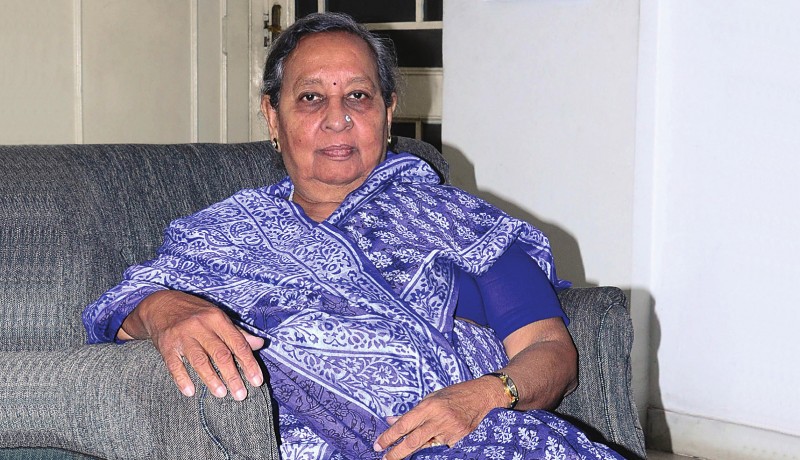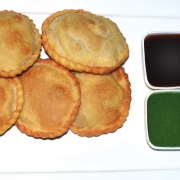
Columns

A series by Pratibha Jain about silvers who believe nurturing the body and mind is the key to joy.
Featuring Neeta Raisurana from Jaipur
As anyone from the Sheherwali community (also known as the Oswal Jains of Murshidabad) will tell you, while chopping vegetables or fruits, the knife should not leave its mark on them. Nothing is cut in a random manner. For instance, if a cucumber is to be chopped for raikhatte ka kheera (cucumber with spices), two cuts are made, dividing it into four pieces; then these are cut into thin, fine, slices. For mirchoni (a cucumber salad), the vegetable is held in one hand and countless slits are made up to one inch like a fine mesh. The cucumber is then sliced, allowing the finely chopped bits to fall directly into the salad bowl. Proceeding inch by inch, the procedure is repeated for the rest of the vegetable.
Neetaji Raisurana gave me this impromptu live demonstration of her knife skills when I met her at her residence in Jaipur. I was introduced to the 78 year-old by renowned chef Sameer Gupta, her ardent admirer who considers her a mother. During my recent stay at Sameerji’s place, he mentioned Neetaji’s name very often, whether we were discussing Hindi literature, seasonal mangoes, or forgotten recipes.
Neetaji is the wife of late Subodhchandji Raisurana. Her daughter Rachna, a former fashion designer, lives in Los Angeles, while son Siddarth, a board member in a recruiting company, lives in Mumbai. She is blessed with five grandchildren. Here are selected excerpts from my conversation with Neetaji, translated from Hindi into English.
LOVE FOR LITERATURE
I inherited the love of reading from my father, Shubhkaranji Bothra. He was fluent in many languages, including Prakrit and Sanskrit. His work in Jain literature was so extensive that many Jain monks treated him like a teacher. He encouraged us to cultivate a love for art and literature. As a youngster, I was often on stage reciting poems and speeches. I have sung at All India Radio, Jaipur. I was also a trained Kathak dancer and fondly recall performing the Rajasthani Gorbandh dance in front of our former prime minister Shri Jawaharlal Nehru. To this day, I enjoy listening to classical music and old film songs and reading good literature. I have read the Mahabharata by various authors and pride myself on knowing the answer to any question from this great epic.
CONFLUENCE OF CULTURES
My life has been a confluence of three Rajasthani cultures: Marwari, Johari and Sheherwali. My maternal family hails from Jaipur; my husband’s family is deeply influenced by the Johari Jains from Benaras; and my mother-in-law has grown up adopting the culture of the Sheherwali Jains. I enjoy the subtle nuances of each culture and pride myself on gaining the best from them. My exposure to a variety of cuisines and life in general happened after marriage. My husband was a connoisseur of food. His love for travel, sports and literature gave me wings to expand my knowledge and become a progressive thinker.
THE SHEHERWALI INFLUENCE
My mother-in-law’s family came from Murshidabad, West Bengal. The Jain Oswals who settled in the region centuries ago were greatly influenced by the Bengali and Nawabi cultures of that time. They came to be known as Sheherwali Jains. Their distinct way of life, eating habits and sense of dressing portrayed the rich lifestyle of the place.
The Sheherwalis are known for their passion for mangoes, with over 100 varieties of mangoes available in Murshidabad. Many delicacies were prepared with this fruit, including sandesh and chakki. My jeth [husband’s elder brother] would sit down patiently and smell each one to predict the exact time it would ripen. This Sheherwali talent for identifying the perfect ripeness of each fruit was almost a kind of ritual.
My mother-in-law inherited the Sheherwali skill of cutting fruits and vegetables. Depending on the dish being made, each ingredient would have its own specific requirement for how it needed to be chopped. The rule to cut pineapples was to slice them so they looked like flowers. Certain mango varieties were peeled from top to bottom, while others needed to be peeled in a concentric circle. Under her training, I became so adept at chopping vegetables and fruits that whenever there was a function or wedding or any event in the neighborhood, I was specially called over to assist with the chopping.
Folding paan was another art form we were expected to master. A staple mouth freshener at every wedding and festival, it was our responsibility to make the paan ourselves, without any assistance from the domestic staff. I recall how six or seven of us would gather to fold hundreds and thousands of paans, each looking perfectly identical as if created by a machine.
SPECIAL INGREDIENTS
Saffron and rosewater are used frequently in Sheherwali cuisine. Saffron is added to most sweets and to pulav. When milk is set to make curds, a few strands of saffron are also added to make kesar dahi. In the summers, it is a common practice to eat leftover rotis with a cooling fruit salad, called paana. For this, we add a dash of sugar and rosewater to chopped fruits like melons, mangoes or oranges.
QUICK LEFTOVER RECIPES
We prefer creating new dishes from leftovers rather than eating the same dish for more than one meal. This penchant for leftover recipes is most popular in Rajasthani culture. Let me share some of my favourite leftover recipes.
Chawal ki pakodi: Tie some curd [yoghurt] in a muslin cloth to drain away the water so you have hung curd. Mix leftover rice with salt, crushed saunf [fennel seeds], and the hung curd. Pat gently into pakodi and set aside [about 20 minutes] until a dry layer forms on top. Deep-fry these in hot oil until crisp. Serve hot with chutney.
Roti ka upma: Tear leftover rotis into pieces. Prepare a rich gravy with onions, tomato puree and spices. Add the bits of torn rotis to the gravy, mix, and switch off the flame. Serve hot.
Roti ki chaat: Tear leftover rotis into pieces and allow it to dry for a day or two. Deep-fry the pieces in hot oil until fully crisp. Use these as a base to make chaat, or simply crush coarsely, mix with chopped onions, tomatoes and seasoning, and serve as a snack.
KHEERE KI KACHORI
Savoury cucumber snack
Mention Sheherwali cuisine and one of the first dishes that comes to mind is kheere ki kachori. This recipe looks deceptively simple yet requires perfection at every step. The pleated edges give this kachori its distinctive look.
Ingredients
- Wheat flour or maida: 2 cups
- Sooji (semolina): ¼ cup
- Cucumbers: 2; grated
- Hung curd/yoghurt: 1 cup
- Red chilli powder: 1 heaped tsp
- Cumin powder: 1 tsp; roasted
- Hing (asafoetida) powder: a pinch; roasted
- Cinnamon powder: ¼ tsp
- Black salt: ¼ tsp
- Salt to taste
- Oil for binding and deep-frying
Method
Mix the flour with sooji and ¼ tsp salt. Add oil (about 3-4 tbsp) and mix well so that when a fistful of flour is pressed, it does not crumble easily. Add enough water to knead into a tight but pliable dough. Knead for a few more minutes and set aside. Cover with a moist cloth. Squeeze out excess water from the grated cucumber. Set aside. To make the filling, combine the cucumber, hung curd, red chilli powder, cumin powder, hing, cinnamon powder, black salt and salt. Mix well. To make the kachori, divide the dough into small lemon-sized balls. Roll each ball into the size of a three-inch roti. Take one roti, spread some of the cucumber filling evenly on top and place another roti over the first one. Press the edges together and fold the ends into small pleats. Making the pleats is an art; if you are not adept at pleating, simply press the ends well so they do not open up. Heat oil and deep-fry 2-3 kachori at a time, on low flame. Flip them over to fry evenly and remove when they turn golden on all sides. Drain on absorbent paper. Serve hot with green and/or tamarind chutney.
Note: During festive meals, this kachori is also served with potato sabzi and chilli pickle (kuti mirch ka achaar).
Pratibha Jain, an author and translator from Chennai, is the co-author of two award-winning books Cooking at Home with Pedatha and Sukham Ayu. Her area of specialisation is documenting Indian traditions through research, translation and writing
Photos: Zakir Hussain Featured in Harmony — Celebrate Age Magazine March 2018
you may also like to read
-
Mental workout
Mukul Sharma tells you how to keep those grey cells ticking Everyone will ultimately lose his or her brain….
-
Helpline
Dr Harshbir Rana answers your queries on personal and social issues related to ageing, elder care and intergenerational relationships ….
-
Off the cuff
Raju Mukherji pays tribute to his first hero, Tenzing Norgay, an exemplary mountaineer Darjeeling, 1955. Dr ‘Pahari’ Guha Mazumdar….
-
Yoga RX
Shameem Akthar shows ways to control debilitating ankle pain through regular practice Ankle pain is so common and prevalent….








